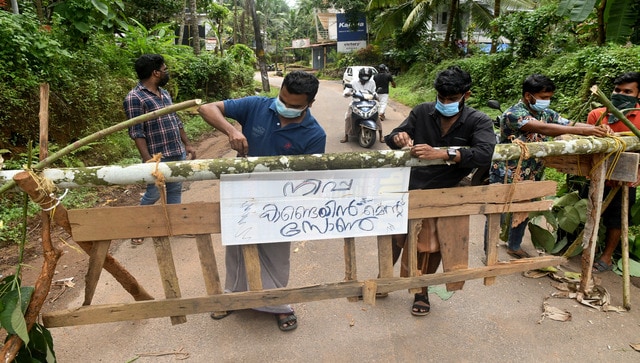Nipah virus in Kerala: Why is the state susceptible to repeated outbreaks?
Nipah virus in Kerala: Why is the state susceptible to repeated outbreaks?

Kerala is battling its fourth outbreak of the Nipah virus since 2018. A 39-year-old man in the Kozhikode district tested positive for the virus, taking the total number of cases in the state to six. While two infected people have died, the rest are currently being treated.
The Kerala government is taking several measures to prevent the spread of the virus, including setting up containment zones, ramping up testing and shutting educational institutions in Kozhikode.
The Rajasthan health department has also issued an advisory to its officials to remain “alert” following the outbreak of the zoonotic disease in Kerala.
Let’s take a look at previous outbreaks of the Nipah virus and why the virus keeps emerging in Kerala.
But first, what is the Nipah virus?
Nipah virus (NiV) is a zoonotic disease, meaning it is transmitted from animals to humans when they come in contact with the bodily fluids of infected bats and pigs.
The virus can also spread through contaminated food or directly between humans, as per the World Health Organization (WHO).
The initial symptoms that infected humans show are fever, headaches, muscle pain, vomiting and sore throat.
“This can be followed by dizziness, drowsiness, altered consciousness, and neurological signs that indicate acute encephalitis. Some people can also experience atypical pneumonia and severe respiratory problems, including acute respiratory distress,” says the WHO website.
However, patients can also be asymptomatic.
Currently, there is no cure or vaccine for the Nipah virus infection. The primary treatment for humans involves supportive care, as per the WHO.
The Nipah virus has a high fatality rate of 40 per cent to 75 per cent.
Role of fruit bats
Fruit bats, also known as flying foxes, are “natural hosts” of the virus. They are known to pass on the virus to other animals like pigs, and also dogs, cats, goats, horses and sheep.
According to India Today, WHO’s factsheet on the Nipah virus states: “There is strong evidence that emergence of bat-related viral infection communicable to humans and animals has been attributed to the loss of natural habitats of bats”.
Although flying foxes are migratory, they do not leave forests when they have enough food.
“As the flying fox habitat is destroyed by human activity the bats get stressed and hungry, their immune system gets weaker, their virus load goes up and a lot of virus spills out in their urine and saliva.”
Humans get infected when they consume fruits or fruit products contaminated with urine or saliva from infected fruit bats.
Previous outbreaks
The Nipah virus was first identified in 1998 during an outbreak among pig farmers in Malaysia. The disease spread to Singapore the next year. The outbreak in these two countries infected roughly 300 people and killed more than 100.
In 2001, Bangladesh reported cases of the Nipah virus. It is believed the virus reached people who drank raw palm sap, usually contaminated with bat urine and saliva. The infection was then transmitted among humans through respiratory droplets, as per The Hindu.
The same year, India witnessed its first cases of the virus in West Bengal’s Siliguri. Out of the 65 infected people, 45 died, reported India Today. All five infected people in the state’s Nadia district in 2007 also lost their lives.
Kerala saw its first outbreak of the brain-damaging Nipah virus in 2018. The disease reported in the district of Kozhikode killed 17 out of the total 18 infected people.

The virus took Kerala by surprise and was identified only after it claimed a few lives.
In 2019, one case was reported in Ernakulam district. No case came to light in 2020 in Kerala. The next year, a 12-year-old boy died in Kozhikode due to the zoonotic disease.
Kerala started implementing social distancing, contact tracing and isolation after the deadly Nipah virus outbreak in 2018. Since the COVID-19 pandemic, Kerala has also upgraded government labs for the detection of viruses, reported Indian Express.
Former Kerala health minister KK Shailaja, who effectively contained the Nipah infection in 2018, said that this year’s situation is not as bad as it was then.
“In 2018, it was a new virus to us, and we did not have any experience battling such an infection. Now, we have everything in place to contain it effectively,” Shailaja told news agency PTI.
Why does Kerala see repeated outbreaks?
According to a Reuters news agency investigation published in May, Kerala witnessed rapid urbanisation and deforestation in recent decades, which “created ideal conditions for a virus like Nipah to emerge.”
Pragya Yadav, the lead scientist on Nipah research at Pune’s National Institute of Virology (NIV), said that due to their habitat loss, animals have come closer to humans, “which eventually helps the virus to jump from bats to humans”, the news agency reported.
Meanwhile, a study by the NIV in Pune has revealed the presence of the Nipah virus in bats in 10 of the 16 surveyed states and Union Territories.
The Nipah viral antibodies were found in Kerala, Tamil Nadu, Karnataka, Goa, Maharashtra, Bihar, West Bengal, Assam, Meghalaya and Puducherry, reported Onmanorama.com citing the ongoing study.
No antibodies in bats were found in Telangana, Gujarat, Punjab, Himachal Pradesh, Odisha, and Chandigarh.

Dr Yadav told the online portal that there are two reasons for Nipah’s reemergence in Kerala – the proximity of human settlements to forests and increased surveillance in the state.
“Not just Kerala, in states along the Western Ghats, human habitations are either close to the forest or within the forests,” leading to high chances of exposure to infected animals.
Whereas, in the North, forested regions are far from human habitation.
She said that cases can go undetected without proper monitoring. “We don’t know if it is causing infection in other states. A certain level of monitoring and surveillance is required to pick up every case,” Dr Yadav told Onmanorama.com. “Hospital-based surveillance should be increased in other states as well”.
According to Hindustan Times (HT), Nipah has three genotypes – Malaysia M, Bangladesh B, and India I. In India, Bangladesh B and India I are the commonly found genotypes.
According to Dr Yadav, the I genotype has been found in Kerala.
However, Kerala health minister Veena George recently said that the Nipah virus strain in Kerala was the less-infectious Bangladesh variant that spreads from human to human and has a high mortality rate, reported PTI.
With inputs from agencies
What's Your Reaction?



























































